Table of contents
- Service: SH 5 Silent hectic alternator Modern power plant for oldies
- The result: not enough juice for the battery
- Solution: a new design
- You can’t see anything of the renovation
- facts and figures
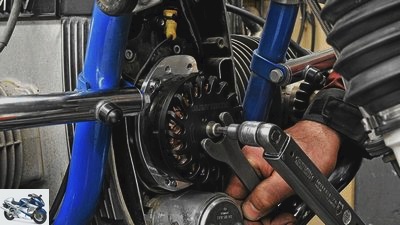
Streblow
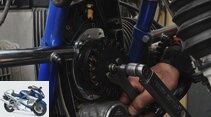
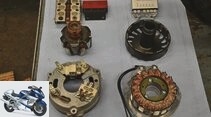
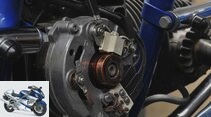
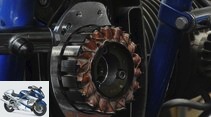
8th pictures
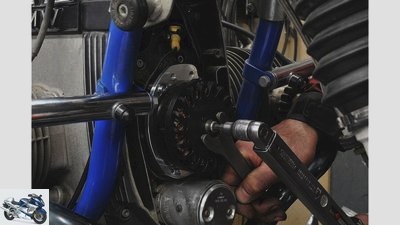
Streblow
1/8
The assembly of the silent hectic on the BMW R 80 GS Basic.
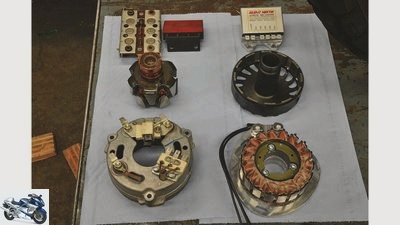
Streblow
2/8
On the left you serial parts, on the right the SH 5. The SH 5 does not have the diode plate on the generator regulator.

Streblow
3/8
The Bosch Lima with carbon brushes.
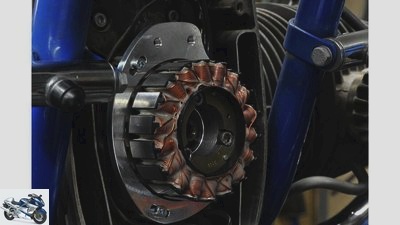
Streblow
4/8
The SH 5 generator from Silent Hastik, here still without the black runner.
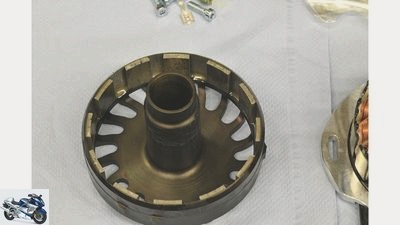
Streblow
5/8
The runner of the silent hectic now rotates outside.
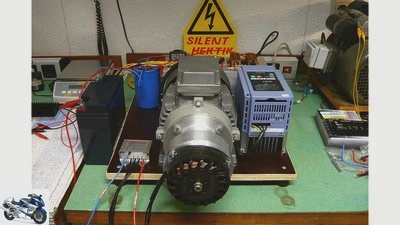
Streblow
6/8
Check the new alternator.
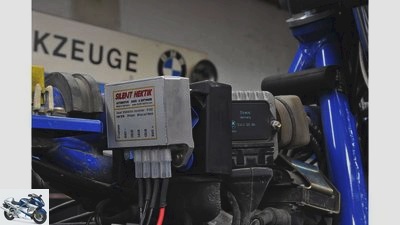
Streblow
7/8
Three-phase current controller from Silent Hastik for precise control of the alternator.
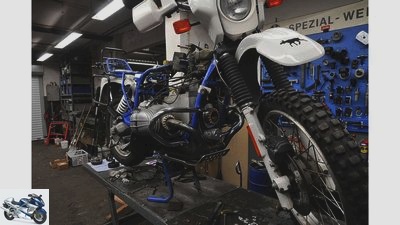
Streblow
8/8
The BMW R 80 GS Basic without alternator and engine.
counselor
workshop
Service silent hectic alternator
Service: SH 5 Silent hectic alternator
Modern power plant for oldies
Content of
The new SH 5 alternator from Silent Hastik for BMW two-valve boxers and Moto Guzzi from V35 to the last Le Mans promises more charging current without thermal problems. MOTORRAD Classic tried the innovation.
Nicolas Streblow
04/17/2013
When Bosch developed the alternators in the 1970s, which sit on the crankshaft of BMW two-valve boxers and Moto Guzzi V engines, there was no compulsory lighting or electronic transistor ignition systems. The charge balance was correct, at most frequent short-distance traffic in the city no longer adequately filled the battery. With the lights on, electronic ignition and additional heated grips, this type of alternator no longer delivers enough power in the lower third of the speed. In addition, the efficiency drops due to the high temperatures in the constant stop and go in the city.
But the old generators don’t like high continuous speeds either. The double-bearing crankshaft can bend so far that the coals start to bounce on the rotor, which is not exactly beneficial for durability. In addition, the generator behind the engine cover runs hot. Heat and vibrations also cause the rotor’s winding to break, as can be seen from a flickering charge indicator light.
The result: not enough juice for the battery
The battery is draining rapidly because it is no longer being charged. In addition, heat and vibrations often put an end to the diode plate in BMW models, which, together with the regulator, manages the charging current of the alternator. It too sits nice and warm behind the engine cover above the alternator. The standard alternator survives best at speeds between slightly below 3000 and almost 6000 tours. It works optimally there, wear and temperature are kept within limits.
Many boxer drivers and guzzisti probably remind these lines of their own mishaps from the last four decades. Other controllers (“Authority regulator”) and – at least on paper – more powerful alternators rarely brought improvement. If so, it was usually short-lived. Because the thermal problem as well as the limited durability at high continuous speeds can only be overcome with a new design.
Solution: a new design
However, with increasing output of the alternator, more and more heat is generated, so that only half a year of development time went into the cooling.
The solution: A rotor that now also functions as a fan, it lowers the temperature from around 180 to 100 degrees, measured in the stator. The magnets do not lose any magnetic force up to 250 degrees, so there are sufficient thermal reserves. Power curves and voltmeters provide information about the performance of the SH 5. A prepared motorcycle was deliberately not used for the measurement, but a private BMW R 80 GS Basic with an otherwise standard ignition system. Shortly after starting, the on-board voltage with the battery not fully charged is around 13 volts, and at a slightly higher idle speed it is already 14 volts.
After driving ten kilometers, the battery is charged enough that the Silent hectic alternator delivers 14 volts while idling with the lights on. While the so-called zero ampere speed – the alternator provides enough power for the ignition and lights, but does not yet charge the battery – is between 2700 and 3200 rpm for the Bosch generator, this value fluctuates around 1300 rpm for the SH Type 5 . This means that there is always enough power available from idle. The construction was able to prove its durability in racing as well as in airplanes.
You can’t see anything of the renovation
The pilot series model was installed by Ralf Huschke from Huschke and Wirth in Bochum. As a development partner of Silent Hastik, Ralf ensures that Toni’s constructions can be assembled with reasonable effort. We thank you for your patience during the photo production. The new generator replaces the old one, the diode plate is thrown out, as is the regulator.
In its place, the supplied Lima controller is installed, which is both regulator and rectifier – a necessity due to the changed generator technology with permanent magnets. You can’t see anything of the renovation. Only when the engine is running is it noticeable that something has changed: the charge control lamp goes out immediately after the engine is started, and that already at the lowest idle speed!
facts and figures
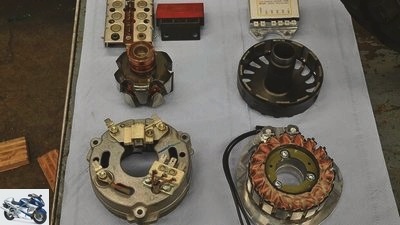
Streblow
On the left the series parts, on the right the SH 5. The diode plate is no longer necessary, the rotor (center) now rotates on the outside.
The Silent hectic alternator SH type 5 is available for the following models:
BMW two-valve boxer:
- all models from / 5 to / 6 to 7/1976, stator centering 105 mm (crankshaft with cone)
- all models from / 6 from 8/1976 to the R 80 GS Basic, stator centering 107mm (crankshaft with cone)
Moto Guzzi:
- all models and years of construction from the V 35 to the last Le Mans 1000, stator centering 105 mm (crankshaft with cone)
- all models and years of construction with 1100 cm³ engines, stator centering 105 mm (cylindrical crankshaft)
Price:
- Alternator SH 5 complete with regulator 497 euros, installation around 120 euros
For comparison, the current prices for BMW original parts:
- Alternator complete 644.58 euros
- Single stator, only ring winding, plus installation: 135 euros
- Rotor: 332 euros (in exchange with free dealers 119 euros)
Information at www.silent-hektik.de and www.hw-bochum.de
Related articles
-
Motorcycle mechanic tip Alternator and battery
Ralf Petersen 18th pictures Ralf Petersen 1/18 Ralf Petersen explains to us what to look out for with the alternator and battery and how to properly…
-
Service check: inspection costs
Harley-Davidson motorcycles Service check: inspection costs Overview of inspection costs What does the professional service cost? Whether for warranty…
-
Cook 15th pictures Cook 1/15 Insert the key, turn it, press the button and off you go. What is now a matter of seconds and a piece of cake even without…
-
Service Price check Japanese super athletes
Jahn counselor workshop Service Price check Japanese super athletes Service price check: Japanese super athletes Big discounts on Japanese motorcycles…
-
Service: maintenance and repair of leather suits
2snap clothing Station wagons, jackets & pants Service: maintenance and repair of leather suits Maintenance and repair of leather suits The second skin…
-
LiveWire conversion: E-Harley Silent Alarm from JvB-Moto
JvB-moto 21 pictures JvB-moto 1/21 Jens vom Brauck, the Cologne customizer and head behind JvB-moto, received the order from Harley to convert a…
-
Service test at the motorcycle dealer
mps photo studio 16 pictures mps photo studio 1/16 Everything was possible between 2400 and around 4300 euros. And in any case understandable, because…
-
BVDM terminates membership in “Silent Rider”
Motorcycle noise Debate about the volume of motorcycles Welcome event company counselor traffic & business BVDM terminates membership in “Silent Rider”…
-
Service: BMW S 1000 RR accessories
archive accesories Service: BMW S 1000 RR accessories Service: add-on parts for BMW’s super sports cars Accessories for the BMW S 1000 RR Content of…
-
Service: Insurance tariffs 2017
Jakub Jirsk, Fotolia counselor traffic & business Service: Insurance tariffs 2017 Service: Insurance tariffs 2017 Full coverage First they promise the…